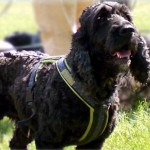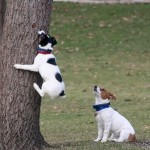Written by Senior Editor Peter Gehr
One of the greatest things you can do for your puppy each day is to take him for a walk. Your dog needs to burn energy, and if you don’t provide that energy burning activity with him every day, your pet will use that energy elsewhere, and that may be detrimental and damaging to you, your property, and your dog. The best puppy dog walking tips that work like a charm are simple and effective, and as the Alpha, or pack leader, you need to be in control and take charge.
One of the first things I would recommend not to do is this: Do not use an extendable leash. I have never liked them, nor is it good for your dog because he sees this as his chance to rule the walk. He will dominate you if you use this type of leash, and the message you are sending him is that you don’t care what he does as long as it’s within the reach of the fully extended leash. This is not a good practice, and is feeding a bad habit.
Remember this simple rule: The best puppy dog walking tips work like a charm, and you are the one that is taking the dog for a walk. The dog is not taking you for a walk. You, and only you, must be in full control, take charge and use a leash that keeps your dog right by your side where he belongs.
Best Puppy Dog Walking Tips That Work Like a Charm
Cesar Millan teaches excellent foundation strategies on how to conduct yourself when walking your dog:
I often walk about ten dogs at a time, sometimes even off-leash if I’m in a safe area. People are amazed by this, but it’s simple: the dogs see me as their pack leader. This is why dogs follow me wherever I go.
1. Position matters.
Walking in front of your dog allows you to be seen as the pack leader. Conversely, if your dog controls you on the walk, he’s the pack leader. You should be the first one out the door and the first one in. Your dog should be beside or behind you during the walk.
2. Use a short dog leash.
This allows you to have more control. Attaching the leash to the very top of the neck can help you more easily communicate, guide, and correct your dog. If you need additional help, consider the Illusion collar. Always keep your dog’s safety in mind when giving corrections.
3. Set aside time.
Dogs, like humans, are diurnal, so taking walks in the morning is ideal. I recommend setting aside thirty minutes to a full hour. The specific needs of each dog differ. Consult your vet and keep an eye on your dog’s behavior to see if his needs are being met.
4. Define exploration time.
After your dog has maintained the proper state of mind, reward him by allowing him to relieve himself and sniff around. Then you need to decide when reward time is over. It should always be less than the time spent focused on the walk.
5. Don’t punch out.
When you get home, don’t stop leading. Have your dog wait patiently while you put away his leash or take off your shoes.
6. Share food and water.
By providing a meal after the walk, you have allowed your dog to “work” for food and water.
And don’t forget to set a good example by always picking up after your dog! Click here to visit the original source of this post
If you implement the best puppy dog walking tips that work like a charm and generate a good relationship between you and your pet, the bonding will be one of strength, trust, respect and knowledge of who the leader is, and who the follower is. There should be a method to your walk and a procedure that your dog understands and abides by the rules, and this will make your dog feel secure, challenged and properly positioned in his/her mind. This is vital to a great relationship between you and your puppy.
Please comment below, and share with your Facebook friends.




